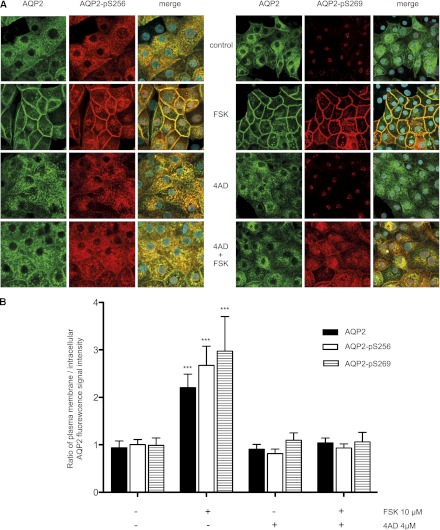Figure 3.
4AD directs the forskolin (FSK) induced phosphorylation of S269 (pS269) to intracellular domains and prevents S256 phosphorylation of AQP2 in primary IMCD cells. (A) The cells were left untreated, incubated with forskolin (10 µM, 20 minutes), 4AD (4 µM, 30 minutes), or a combination of 4AD and FSK. AQP2 was detected using specific primary antibodies (C-17, Santa Cruz) and Cy2-coupled antigoat secondary antibodies (green).19 AQP2-pS256 was detected using specific antiphospho primary and Cy3-coupled secondary antibodies.25 AQP2-pS269 was detected using specific antiphospho primary (p112–269, Phosphosolutions) and Cy3-coupled secondary antibodies. Nuclei were stained with DAPI (blue). Shown are representative images from one of three independent experiments. (B) The intensities of intracellular and plasma membrane immunofluorescence signals arising from AQP2, AQP2-pS256, and AQP2-S269 were determined and related to nuclear signal intensities (n≥30 cells per condition; mean ±SEM; three independent experiments). The ratios of plasma membrane to intracellular fluorescence signal intensities were calculated. Ratios >1 indicate a predominant localization at the plasma membrane. Values significantly different from control cells and cells treated with 4AD or forskolin and 4AD are indicated (***P<0.001).

